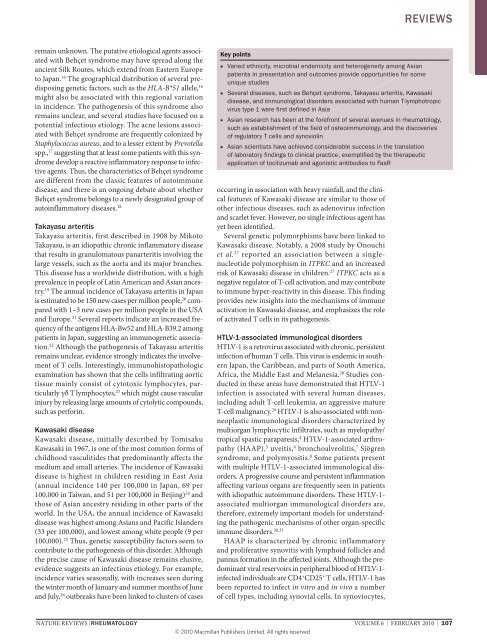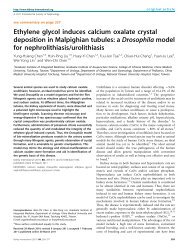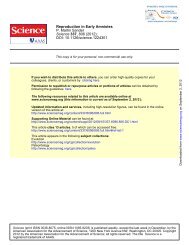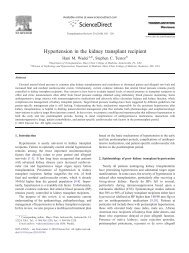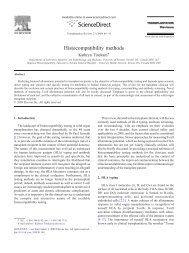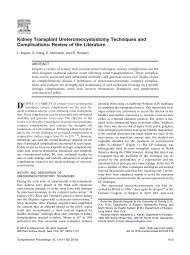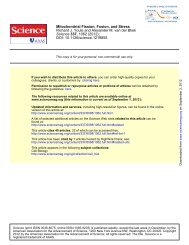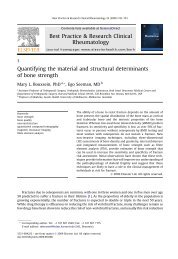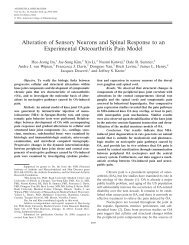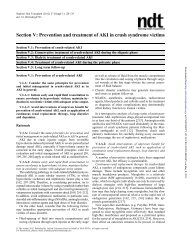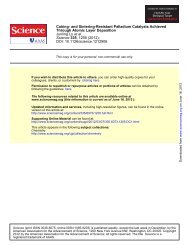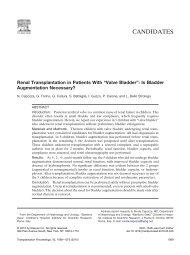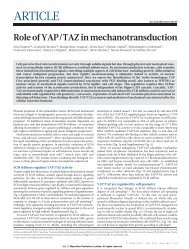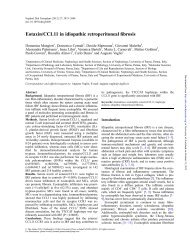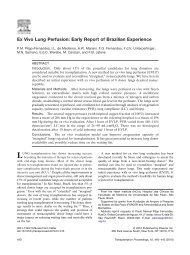The contribution of Asian researchers to the field of rheumatology
The contribution of Asian researchers to the field of rheumatology
The contribution of Asian researchers to the field of rheumatology
Create successful ePaper yourself
Turn your PDF publications into a flip-book with our unique Google optimized e-Paper software.
emain unknown. <strong>The</strong> putative etiological agents associated<br />
with Behçet syndrome may have spread along <strong>the</strong><br />
ancient Silk Routes, which extend from Eastern Europe<br />
<strong>to</strong> Japan. 16 <strong>The</strong> geographical distribution <strong>of</strong> several predisposing<br />
genetic fac<strong>to</strong>rs, such as <strong>the</strong> HLA‑B*51 allele, 16<br />
might also be associated with this regional variation<br />
in incidence. <strong>The</strong> pathogenesis <strong>of</strong> this syndrome also<br />
remains unclear, and several studies have focused on a<br />
potential infectious etiology. <strong>The</strong> acne lesions associated<br />
with Behçet syndrome are frequently colonized by<br />
Staphylococcus aureus, and <strong>to</strong> a lesser extent by Prevotella<br />
spp., 17 suggesting that at least some patients with this syndrome<br />
develop a reactive inflamma<strong>to</strong>ry response <strong>to</strong> infective<br />
agents. Thus, <strong>the</strong> characteristics <strong>of</strong> Behçet syndrome<br />
are different from <strong>the</strong> classic features <strong>of</strong> au<strong>to</strong>immune<br />
disease, and <strong>the</strong>re is an ongoing debate about whe<strong>the</strong>r<br />
Behçet syndrome belongs <strong>to</strong> a newly designated group <strong>of</strong><br />
au<strong>to</strong>inflamma<strong>to</strong>ry diseases. 18<br />
Takayasu arteritis<br />
Takayasu arteritis, first described in 1908 by Miko<strong>to</strong><br />
Takayasu, is an idiopathic chronic inflamma<strong>to</strong>ry disease<br />
that results in granuloma<strong>to</strong>us panarteritis involving <strong>the</strong><br />
large vessels, such as <strong>the</strong> aorta and its major branches.<br />
This disease has a worldwide distribution, with a high<br />
prevalence in people <strong>of</strong> Latin American and <strong>Asian</strong> ancestry.<br />
19 <strong>The</strong> annual incidence <strong>of</strong> Takayasu arteritis in Japan<br />
is estimated <strong>to</strong> be 150 new cases per million people, 20 compared<br />
with 1–3 new cases per million people in <strong>the</strong> uSA<br />
and Europe. 21 Several reports indicate an increased frequency<br />
<strong>of</strong> <strong>the</strong> antigens HLA-Bw52 and HLA-B39.2 among<br />
patients in Japan, suggesting an immunogenetic association.<br />
22 Although <strong>the</strong> pathogenesis <strong>of</strong> Takayasu arteritis<br />
remains unclear, evidence strongly indicates <strong>the</strong> involvement<br />
<strong>of</strong> T cells. Interestingly, immuno his<strong>to</strong>pathologic<br />
examination has shown that <strong>the</strong> cells infiltrating aortic<br />
tissue mainly consist <strong>of</strong> cy<strong>to</strong><strong>to</strong>xic lymphocytes, particularly<br />
γδ T lymphocytes, 23 which might cause vascular<br />
injury by releasing large amounts <strong>of</strong> cy<strong>to</strong>lytic compounds,<br />
such as perforin.<br />
Kawasaki disease<br />
Kawasaki disease, initially described by Tomisaku<br />
Kawasaki in 1967, is one <strong>of</strong> <strong>the</strong> most common forms <strong>of</strong><br />
childhood vasculitides that predominantly affects <strong>the</strong><br />
medium and small arteries. <strong>The</strong> incidence <strong>of</strong> Kawasaki<br />
disease is highest in children residing in East Asia<br />
(annual incidence 140 per 100,000 in Japan, 69 per<br />
100,000 in Taiwan, and 51 per 100,000 in Beijing) 24 and<br />
those <strong>of</strong> <strong>Asian</strong> ancestry residing in o<strong>the</strong>r parts <strong>of</strong> <strong>the</strong><br />
world. In <strong>the</strong> uSA, <strong>the</strong> annual incidence <strong>of</strong> Kawasaki<br />
disease was highest among <strong>Asian</strong>s and Pacific Islanders<br />
(33 per 100,000), and lowest among white people (9 per<br />
100,000). 25 Thus, genetic susceptibility fac<strong>to</strong>rs seem <strong>to</strong><br />
contribute <strong>to</strong> <strong>the</strong> pathogenesis <strong>of</strong> this disorder. Although<br />
<strong>the</strong> precise cause <strong>of</strong> Kawasaki disease remains elusive,<br />
evidence suggests an infectious etiology. For example,<br />
incidence varies seasonally, with increases seen during<br />
<strong>the</strong> winter month <strong>of</strong> January and summer months <strong>of</strong> June<br />
and July, 26 outbreaks have been linked <strong>to</strong> clusters <strong>of</strong> cases<br />
Key points<br />
■ Varied ethnicity, microbial endemicity and heterogeneity among <strong>Asian</strong><br />
patients in presentation and outcomes provide opportunities for some<br />
unique studies<br />
reviews<br />
■ Several diseases, such as Behçet syndrome, Takayasu arteritis, Kawasaki<br />
disease, and immunological disorders associated with human T‑lymphotropic<br />
virus type 1 were first defined in Asia<br />
■ <strong>Asian</strong> research has been at <strong>the</strong> forefront <strong>of</strong> several avenues in rheuma<strong>to</strong>logy,<br />
such as establishment <strong>of</strong> <strong>the</strong> <strong>field</strong> <strong>of</strong> osteoimmunology, and <strong>the</strong> discoveries<br />
<strong>of</strong> regula<strong>to</strong>ry T cells and synoviolin<br />
■ <strong>Asian</strong> scientists have achieved considerable success in <strong>the</strong> translation<br />
<strong>of</strong> labora<strong>to</strong>ry findings <strong>to</strong> clinical practice, exemplified by <strong>the</strong> <strong>the</strong>rapeutic<br />
application <strong>of</strong> <strong>to</strong>cilizumab and agonistic antibodies <strong>to</strong> Fasr<br />
occurring in association with heavy rainfall, and <strong>the</strong> clinical<br />
features <strong>of</strong> Kawasaki disease are similar <strong>to</strong> those <strong>of</strong><br />
o<strong>the</strong>r infectious diseases, such as adenovirus infection<br />
and scarlet fever. However, no single infectious agent has<br />
yet been identified.<br />
Several genetic polymorphisms have been linked <strong>to</strong><br />
Kawasaki disease. Notably, a 2008 study by Onouchi<br />
et al. 27 reported an association between a singlenucleotide<br />
polymorphism in ITPKC and an increased<br />
risk <strong>of</strong> Kawasaki disease in children. 27 ITPKC acts as a<br />
negative regula<strong>to</strong>r <strong>of</strong> T-cell activation, and may contribute<br />
<strong>to</strong> immune hyper-reactivity in this disease. This finding<br />
provides new insights in<strong>to</strong> <strong>the</strong> mechanisms <strong>of</strong> immune<br />
activation in Kawasaki disease, and emphasizes <strong>the</strong> role<br />
<strong>of</strong> activated T cells in its pathogenesis.<br />
hTlv‑1‑associated immunological disorders<br />
HTLV-1 is a retrovirus associated with chronic, persistent<br />
infection <strong>of</strong> human T cells. This virus is endemic in sou<strong>the</strong>rn<br />
Japan, <strong>the</strong> Caribbean, and parts <strong>of</strong> South America,<br />
Africa, <strong>the</strong> Middle East and Melanesia. 28 Studies conducted<br />
in <strong>the</strong>se areas have demonstrated that HTLV-1<br />
infection is associated with several human diseases,<br />
including adult T-cell leukemia, an aggressive mature<br />
T-cell malignancy. 29 HTLV-1 is also associated with nonneoplastic<br />
immunological disorders charac terized by<br />
multiorgan lymphocytic infiltrates, such as myelopathy/<br />
tropical spastic paraparesis, 4 HTLV-1-associated arthropathy<br />
(HAAP), 5 uveitis, 6 bronchoalveolitis, 7 Sjögren<br />
syndrome, and polymyositis. 8 Some patients present<br />
with multiple HTLV-1-associated immuno logical disorders.<br />
A progressive course and persistent inflammation<br />
affecting various organs are frequently seen in patients<br />
with idiopathic au<strong>to</strong>immune disorders. <strong>The</strong>se HTLV-1associated<br />
multiorgan immunological disorders are,<br />
<strong>the</strong>refore, extremely important models for understanding<br />
<strong>the</strong> pathogenic mechanisms <strong>of</strong> o<strong>the</strong>r organ-specific<br />
immune disorders. 30,31<br />
HAAP is characterized by chronic inflamma<strong>to</strong>ry<br />
and proliferative synovitis with lymphoid follicles and<br />
pannus formation in <strong>the</strong> affected joints. Although <strong>the</strong> predominant<br />
viral reservoirs in peripheral blood <strong>of</strong> HTLV-1infected<br />
individuals are CD4 + CD25 + T cells, HTLV-1 has<br />
been reported <strong>to</strong> infect in vitro and in vivo a number<br />
<strong>of</strong> cell types, including synovial cells. In synoviocytes,<br />
NATuRE REVIEWS | rheumATologY VOLuME 6 | FEBRuARY 2010 | 107<br />
© 20 10<br />
Macmillan Publishers Limited. All rights reserved


